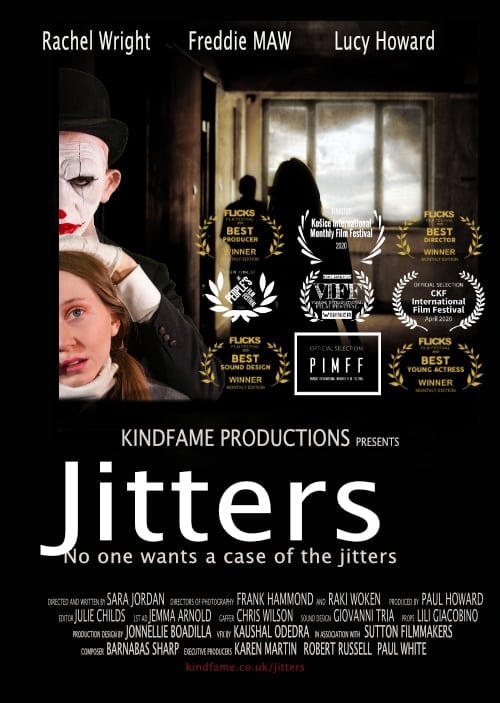Jitters – Synopsis
As a child, a girl manifests her anxiety in the form of an unwanted imaginary friend. Every time she finds herself in a situation which makes her anxious, a creepy and seemingly malevolent clown appears. The more she struggles to push him away, the stronger he gets. She has to find a way to release herself from his power in order to live her life without fear.
Jitters Trailer
Jitters Film Details
Genre: Dark Comedy
Duration: 6:53
Status: Released
Synopsis
Will she be able to rid herself of this oppressive presence as an adult?
Jitters Press Kit
Download the press kit here.

| Producer | Paul Howard |
| Director | Sara Jordan |
| Screenwriter | Sara Jordan |
| 1st AD / Script Supervisor | Jemma Arnold |
| Director of Photography | Frank Hammond Raki Woken |
| Gaffer | Chris Wilson |
| Make-Up | Fiona Stuteley |
| Sound Recordist | Ben Taylor Ben Woolley |
| Cast |
|
| Woman | Rachel Wright |
| Clown | Freddie Maw |
| Girl | Lucy Howard |
Film Critic Review
Jitters
Jitters takes us into the day-to-day struggle of a young girl who is being pursued by a mysterious figure that seems intent on dominating her life through fear. She describes for us her history with the presence, which began suddenly when she was very little. This dark influence in her life is personified as a malevolent clown; one with deep, prominent wrinkles on his face and dark, glaring eyes, as if he is looking out from an eternal rage. He is topped off with an old-fashioned bowler hat and completes the outfit with a flashing, light-up bow tie. In short, he’s a terrifying presence for anyone of any age, but particularly to a youthful girl who is still prone to sleeping in between her parents whenever she’s given a scare. There is nothing unusual about this type of childhood experience; so at first, we are inclined to not make too much of it.
There is a voice-over narration of a grown woman, telling us about it in a manner that communicates this is more significant than typical childhood fears.
She tells us when it started and the effect that it had on what we understand to be the woman’s younger self. The incidents become more and more alarming, such as when the clown suddenly appears, as the young woman is trying to spend time with a new boyfriend. It can also be seen popping up on outings with her friends.
The overall sense that we get, as the immediate shock wears off, is that this vision is isolating her within all of her relationships. We can see the way in which even everyday activities, such as riding on the train, are suddenly turned into moments of fear and discomfort.
The alienating effect can finally be seen in the young woman. She pulls back from social interaction and begins to spend most of her time laying around in her bed at home. While the clown is still there, he is no longer filling her with jolts of fright and shock. Rather, his presence is one of dread and despair. He lays idle in spaces now, just looking on at her, as if to remind her that he is and always will be there. The woman even describes him as whispering into her ear, constantly harassing her with the reassurance that he has complete control over her life. We feel the woman’s frustration and torment as she describes the way in which the clown seems to get stronger any time she thinks about leaving her home. This is about the turning point in the film when we realise this is not just a horror film about creepy clowns, but has something much deeper to say about a more tangible menace.
She describes how a doctor provided her pills to help her cope with the experience, but they just seem to mute her feelings, without removing the image from her mind. She says they simply just made the figure “blurry.” We see her literally struggling with the creature now, as it becomes continually more and more overbearing, and we understand that he is a manifestation of her personal anxiety. It is from a sense of deep defeat, or perhaps from just having no other available options, that the woman finally comes upon an approach that may free her from the thing that’s pushed her around for all of these years. She decides to face it directly. This is not to go to war with it, but rather to simply acknowledge and be ever aware of its presence, rather than repressing it and the feelings it brings about. Suddenly, the being is stripped of its’ overpowering influence and becomes a grovelling mope, a shell of its previous insidiousness.
This brings to mind the endings we often see in horror films that use a similar approach (Freddy Krueger was conquered in a similar fashion, for example), but it’s through this familiarity with the horror genre, that the real experience of dealing with anxiety is made tangible. Audiences, who may find a more clinical explanation obtuse, will easily be able to understand the plight of the anxiety sufferer through this film’s visceral examination of it. Bright colours and interesting compositions make the film a treat for the eyes as well, as we soak in different locations with the knowledge and expectation that we’ll soon be seeing the familiar menace around one of the corners. A jazzy and slightly ethereal score sets a playful mood, even when the subject matter is turning to darker feelings. The film’s primary goal of capturing and making relatable the experience of this condition is, without a doubt, a great success, and keeps us entertained along the way.

